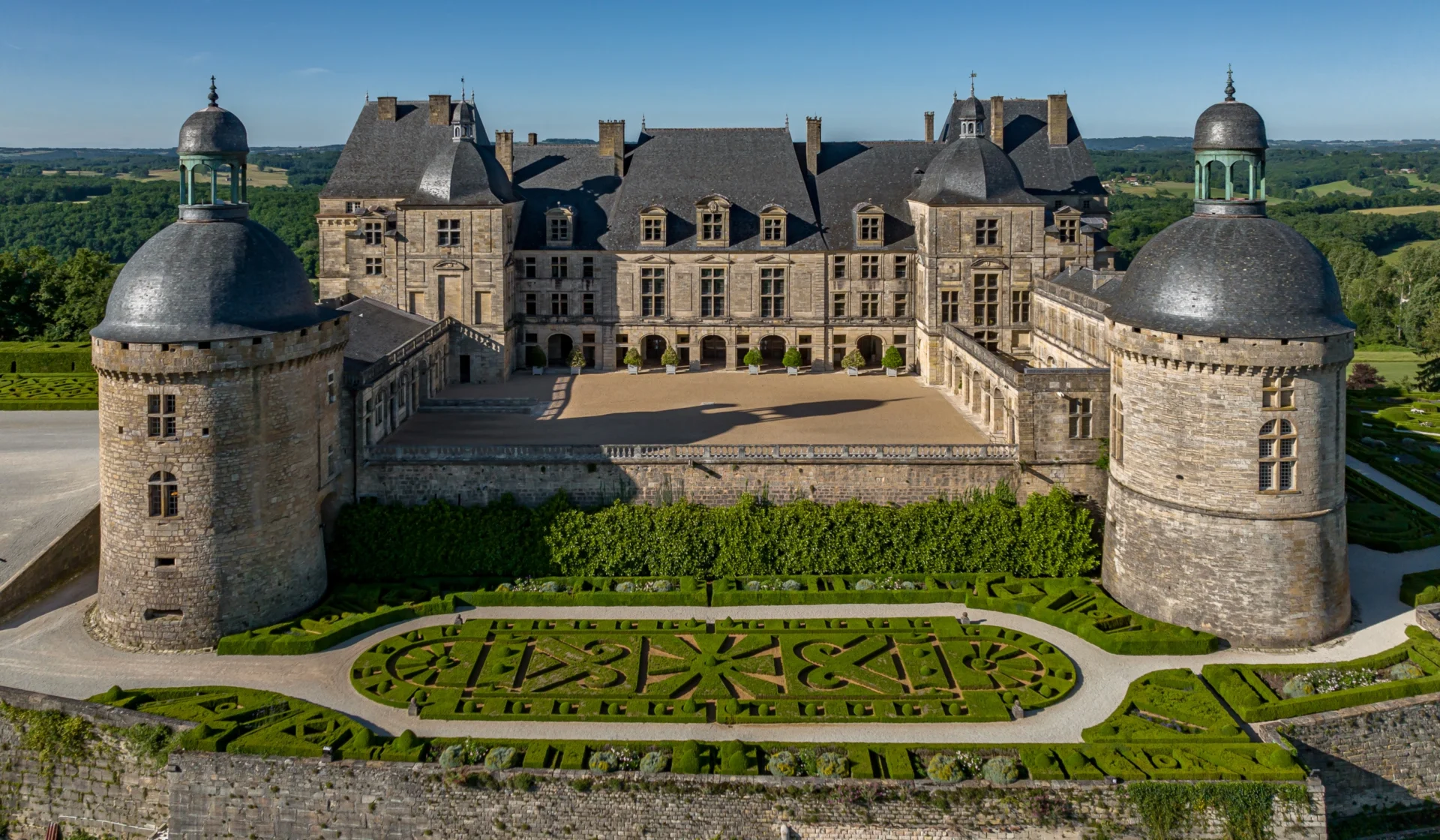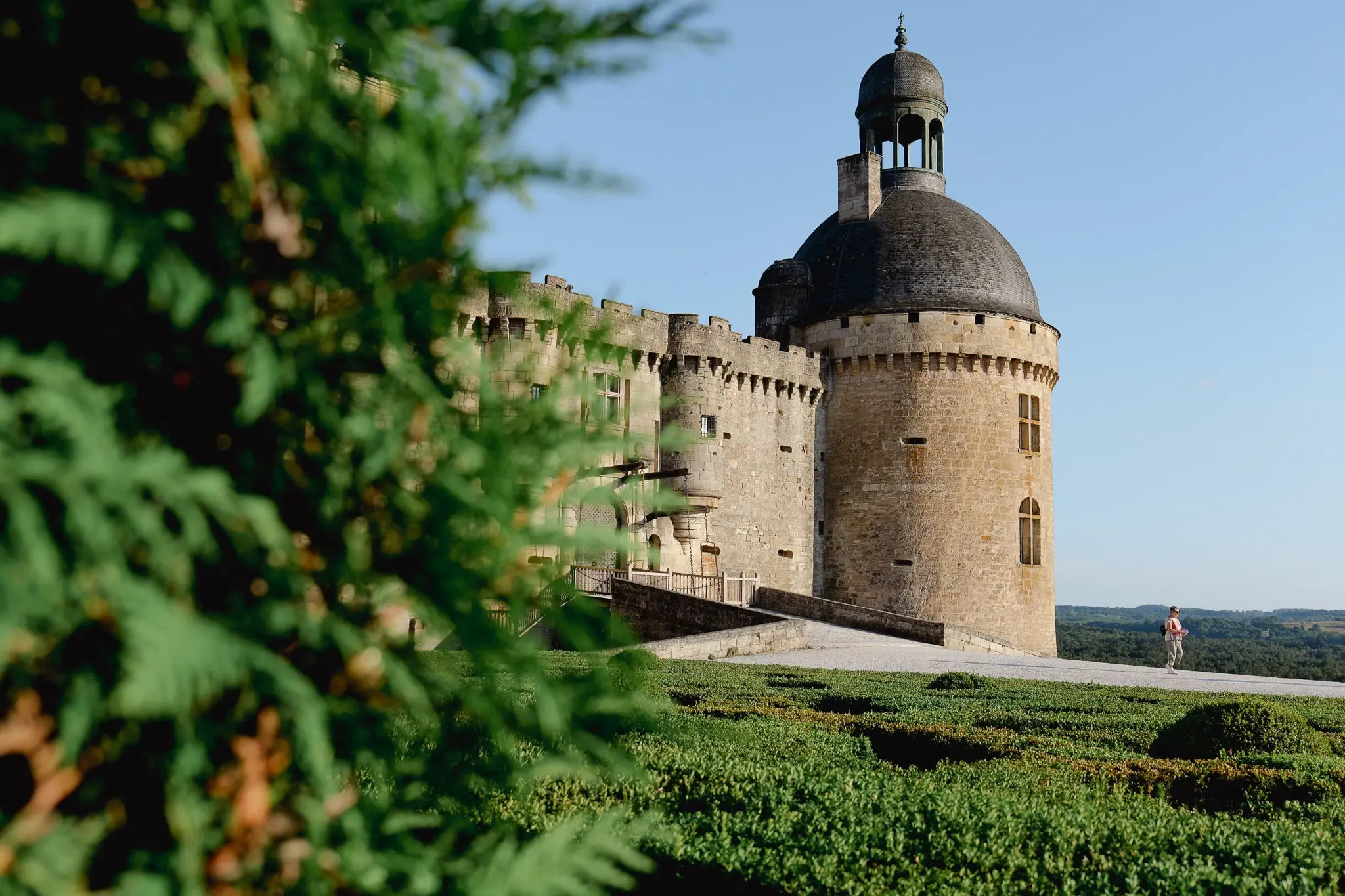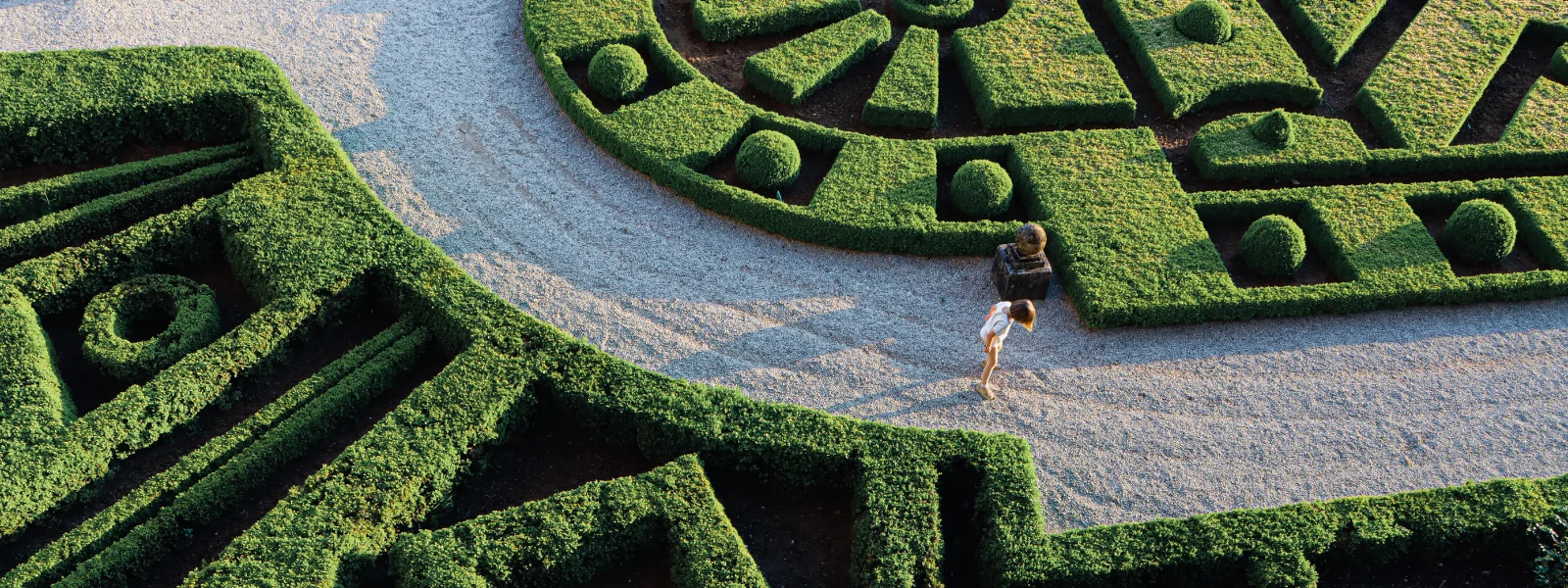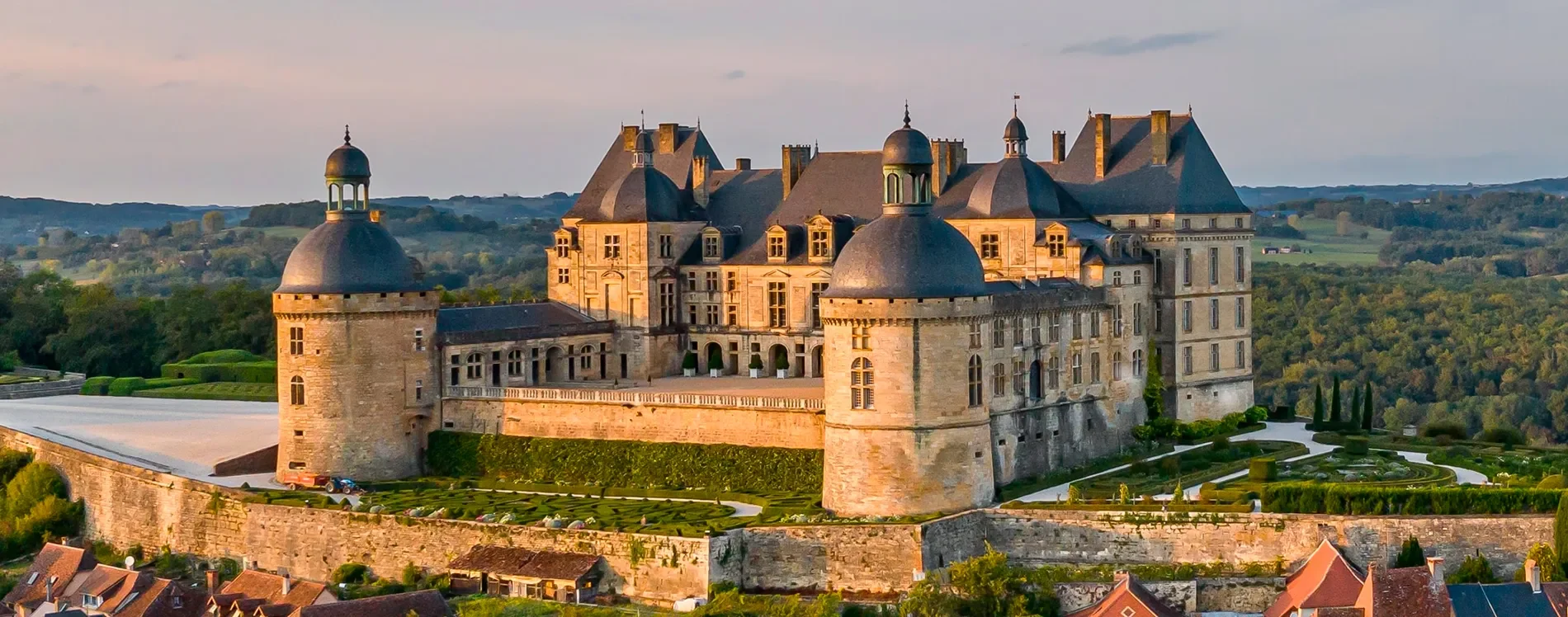Splendour and Refinement through the Centuries
The architecture of classical châteaux embodies the quintessence of refinement and grandeur that marked Europe, and France in particular, from the 16th to the 18th century.
These majestic buildings, symbols of power and prestige, bear witness to a time when art and architecture were used to impress, amaze and establish the authority of nobles and monarchs. To visit these châteaux is to plunge into a world of beauty, symmetry and architectural innovation.
The Emergence of the Classical Style
The architecture of classical castles emerged during the Renaissance, a period of artistic and cultural renewal that saw the rediscovery of the aesthetic principles of Greco-Roman antiquity. Architects of the time, inspired by the harmonious proportions and sophisticated ornamentation of ancient architecture, began to design buildings that combined grandeur and elegance.
The Château de Chambord, built under François I, is an emblematic example of this influence. Designed by Domenico da Cortona and influenced by Leonardo da Vinci, Chambord blends Gothic and Renaissance elements, with its vast double-helix staircases and facades adorned with pilasters and mullioned windows.
Characteristics of Classical Architecture
Classical châteaux are distinguished by a number of architectural and aesthetic features:
- Symmetry and proportion: Inspired by the treatises of Vitruvius and the works of Palladio, classical châteaux are designed according to strict rules of symmetry and proportion. The facades are balanced, with architectural elements arranged in a regular and harmonious manner.
- Use of columns and pilasters: Doric, Ionic and Corinthian columns, as well as pilasters, are frequently used to decorate façades and structure interior spaces. These elements lend a classical grandeur and dignity to buildings.
- Pediments and entablatures: Triangular pediments and entablatures, inspired by ancient temples, are often used to crown doors, windows and main façades, adding a touch of majesty.
- Roofs and Mansards: Gently sloping roofs, often embellished with dormer windows and ornate chimneys, are characteristic of classical châteaux. Mansard roofs, named after the architect François Mansart, are particularly emblematic of this period.
Grands Châteaux Classiques
The Château de Versailles is without doubt the most famous example of classical architecture in France. Built for Louis XIV, the Sun King, by architects Louis Le Vau, Jules Hardouin-Mansart and ornamentalist Charles Le Brun, Versailles epitomises royal grandeur. With its monumental façade, French-style gardens designed by André Le Nôtre and sumptuously decorated interiors, Versailles is a celebration of absolute power and refined taste.
The Château de Vaux-le-Vicomte, built for Nicolas Fouquet by the architect Louis Le Vau, the painter-decorator Charles Le Brun and the landscape gardener André Le Nôtre, is another masterpiece of classical architecture. The perfect harmony between the château, gardens and outbuildings had a profound influence on the design of Versailles.
The Influence of Classical Architecture
The architecture of classical castles has had a lasting influence on the construction of aristocratic and royal residences throughout Europe. From the Baroque palaces of Germany and Austria to the Palladian mansions of England, the principles of symmetry, proportion and refined decoration have crossed borders and centuries.
Classic castles continue to inspire modern architects and captivate visitors from all over the world. Their timeless beauty, majestic grandeur and perfect harmony between architecture and landscape make them essential jewels of world heritage.
To explore the classic châteaux is to immerse yourself in a world of splendour and refinement. Every stone and every ornament tells a story of power, culture and taste. Whether strolling through the formal gardens of Versailles, admiring the symmetrical facades of Vaux-le-Vicomte, or exploring the sumptuous interiors of Chambord, visitors are transported back to a time when architecture was the ultimate expression of human grandeur.
For lovers of history, art and architecture, classic castles offer an unforgettable experience, a journey back in time where beauty and majesty reign supreme.
The architecture of classical châteaux embodies the quintessence of refinement and grandeur that marked Europe, and France in particular, from the 16th to the 18th century.
These majestic buildings, symbols of power and prestige, bear witness to a time when art and architecture were used to impress, amaze and establish the authority of nobles and monarchs. To visit these châteaux is to plunge into a world of beauty, symmetry and architectural innovation.
The Emergence of the Classical Style
The architecture of classical castles emerged during the Renaissance, a period of artistic and cultural renewal that saw the rediscovery of the aesthetic principles of Greco-Roman antiquity. Architects of the time, inspired by the harmonious proportions and sophisticated ornamentation of ancient architecture, began to design buildings that combined grandeur and elegance.
The Château de Chambord, built under François I, is an emblematic example of this influence. Designed by Domenico da Cortona and influenced by Leonardo da Vinci, Chambord blends Gothic and Renaissance elements, with its vast double-helix staircases and facades adorned with pilasters and mullioned windows.
Characteristics of Classical Architecture
Classical châteaux are distinguished by a number of architectural and aesthetic features:
- Symmetry and proportion: Inspired by the treatises of Vitruvius and the works of Palladio, classical châteaux are designed according to strict rules of symmetry and proportion. The facades are balanced, with architectural elements arranged in a regular and harmonious manner.
- Use of columns and pilasters: Doric, Ionic and Corinthian columns, as well as pilasters, are frequently used to decorate façades and structure interior spaces. These elements lend a classical grandeur and dignity to buildings.
- Pediments and entablatures: Triangular pediments and entablatures, inspired by ancient temples, are often used to crown doors, windows and main façades, adding a touch of majesty.
- Roofs and Mansards: Gently sloping roofs, often embellished with dormer windows and ornate chimneys, are characteristic of classical châteaux. Mansard roofs, named after the architect François Mansart, are particularly emblematic of this period.
Grands Châteaux Classiques
The Château de Versailles is without doubt the most famous example of classical architecture in France. Built for Louis XIV, the Sun King, by architects Louis Le Vau, Jules Hardouin-Mansart and ornamentalist Charles Le Brun, Versailles epitomises royal grandeur. With its monumental façade, French-style gardens designed by André Le Nôtre and sumptuously decorated interiors, Versailles is a celebration of absolute power and refined taste.
The Château de Vaux-le-Vicomte, built for Nicolas Fouquet by the architect Louis Le Vau, the painter-decorator Charles Le Brun and the landscape gardener André Le Nôtre, is another masterpiece of classical architecture. The perfect harmony between the château, gardens and outbuildings had a profound influence on the design of Versailles.
The Influence of Classical Architecture
The architecture of classical castles has had a lasting influence on the construction of aristocratic and royal residences throughout Europe. From the Baroque palaces of Germany and Austria to the Palladian mansions of England, the principles of symmetry, proportion and refined decoration have crossed borders and centuries.
Classic castles continue to inspire modern architects and captivate visitors from all over the world. Their timeless beauty, majestic grandeur and perfect harmony between architecture and landscape make them essential jewels of world heritage.
To explore the classic châteaux is to immerse yourself in a world of splendour and refinement. Every stone and every ornament tells a story of power, culture and taste. Whether strolling through the formal gardens of Versailles, admiring the symmetrical facades of Vaux-le-Vicomte, or exploring the sumptuous interiors of Chambord, visitors are transported back to a time when architecture was the ultimate expression of human grandeur.
For lovers of history, art and architecture, classic castles offer an unforgettable experience, a journey back in time where beauty and majesty reign supreme.
The architecture of classical châteaux embodies the quintessence of refinement and grandeur that marked Europe, and France in particular, from the 16th to the 18th century.
These majestic buildings, symbols of power and prestige, bear witness to a time when art and architecture were used to impress, amaze and establish the authority of nobles and monarchs. To visit these châteaux is to plunge into a world of beauty, symmetry and architectural innovation.
The Emergence of the Classical Style
The architecture of classical castles emerged during the Renaissance, a period of artistic and cultural renewal that saw the rediscovery of the aesthetic principles of Greco-Roman antiquity. Architects of the time, inspired by the harmonious proportions and sophisticated ornamentation of ancient architecture, began to design buildings that combined grandeur and elegance.
The Château de Chambord, built under François I, is an emblematic example of this influence. Designed by Domenico da Cortona and influenced by Leonardo da Vinci, Chambord blends Gothic and Renaissance elements, with its vast double-helix staircases and facades adorned with pilasters and mullioned windows.
Characteristics of Classical Architecture
Classical châteaux are distinguished by a number of architectural and aesthetic features:
- Symmetry and proportion: Inspired by the treatises of Vitruvius and the works of Palladio, classical châteaux are designed according to strict rules of symmetry and proportion. The facades are balanced, with architectural elements arranged in a regular and harmonious manner.
- Use of columns and pilasters: Doric, Ionic and Corinthian columns, as well as pilasters, are frequently used to decorate façades and structure interior spaces. These elements lend a classical grandeur and dignity to buildings.
- Pediments and entablatures: Triangular pediments and entablatures, inspired by ancient temples, are often used to crown doors, windows and main façades, adding a touch of majesty.
- Roofs and Mansards: Gently sloping roofs, often embellished with dormer windows and ornate chimneys, are characteristic of classical châteaux. Mansard roofs, named after the architect François Mansart, are particularly emblematic of this period.
Grands Châteaux Classiques
The Château de Versailles is without doubt the most famous example of classical architecture in France. Built for Louis XIV, the Sun King, by architects Louis Le Vau, Jules Hardouin-Mansart and ornamentalist Charles Le Brun, Versailles epitomises royal grandeur. With its monumental façade, French-style gardens designed by André Le Nôtre and sumptuously decorated interiors, Versailles is a celebration of absolute power and refined taste.
The Château de Vaux-le-Vicomte, built for Nicolas Fouquet by the architect Louis Le Vau, the painter-decorator Charles Le Brun and the landscape gardener André Le Nôtre, is another masterpiece of classical architecture. The perfect harmony between the château, gardens and outbuildings had a profound influence on the design of Versailles.
The Influence of Classical Architecture
The architecture of classical castles has had a lasting influence on the construction of aristocratic and royal residences throughout Europe. From the Baroque palaces of Germany and Austria to the Palladian mansions of England, the principles of symmetry, proportion and refined decoration have crossed borders and centuries.
Classic castles continue to inspire modern architects and captivate visitors from all over the world. Their timeless beauty, majestic grandeur and perfect harmony between architecture and landscape make them essential jewels of world heritage.
To explore the classic châteaux is to immerse yourself in a world of splendour and refinement. Every stone and every ornament tells a story of power, culture and taste. Whether strolling through the formal gardens of Versailles, admiring the symmetrical facades of Vaux-le-Vicomte, or exploring the sumptuous interiors of Chambord, visitors are transported back to a time when architecture was the ultimate expression of human grandeur.
For lovers of history, art and architecture, classic castles offer an unforgettable experience, a journey back in time where beauty and majesty reign supreme.
The architecture of classical châteaux embodies the quintessence of refinement and grandeur that marked Europe, and France in particular, from the 16th to the 18th century.
These majestic buildings, symbols of power and prestige, bear witness to a time when art and architecture were used to impress, amaze and establish the authority of nobles and monarchs. To visit these châteaux is to plunge into a world of beauty, symmetry and architectural innovation.
The Emergence of the Classical Style
The architecture of classical castles emerged during the Renaissance, a period of artistic and cultural renewal that saw the rediscovery of the aesthetic principles of Greco-Roman antiquity. Architects of the time, inspired by the harmonious proportions and sophisticated ornamentation of ancient architecture, began to design buildings that combined grandeur and elegance.
The Château de Chambord, built under François I, is an emblematic example of this influence. Designed by Domenico da Cortona and influenced by Leonardo da Vinci, Chambord blends Gothic and Renaissance elements, with its vast double-helix staircases and facades adorned with pilasters and mullioned windows.
Characteristics of Classical Architecture
Classical châteaux are distinguished by a number of architectural and aesthetic features:
- Symmetry and proportion: Inspired by the treatises of Vitruvius and the works of Palladio, classical châteaux are designed according to strict rules of symmetry and proportion. The facades are balanced, with architectural elements arranged in a regular and harmonious manner.
- Use of columns and pilasters: Doric, Ionic and Corinthian columns, as well as pilasters, are frequently used to decorate façades and structure interior spaces. These elements lend a classical grandeur and dignity to buildings.
- Pediments and entablatures: Triangular pediments and entablatures, inspired by ancient temples, are often used to crown doors, windows and main façades, adding a touch of majesty.
- Roofs and Mansards: Gently sloping roofs, often embellished with dormer windows and ornate chimneys, are characteristic of classical châteaux. Mansard roofs, named after the architect François Mansart, are particularly emblematic of this period.
Grands Châteaux Classiques
The Château de Versailles is without doubt the most famous example of classical architecture in France. Built for Louis XIV, the Sun King, by architects Louis Le Vau, Jules Hardouin-Mansart and ornamentalist Charles Le Brun, Versailles epitomises royal grandeur. With its monumental façade, French-style gardens designed by André Le Nôtre and sumptuously decorated interiors, Versailles is a celebration of absolute power and refined taste.
The Château de Vaux-le-Vicomte, built for Nicolas Fouquet by the architect Louis Le Vau, the painter-decorator Charles Le Brun and the landscape gardener André Le Nôtre, is another masterpiece of classical architecture. The perfect harmony between the château, gardens and outbuildings had a profound influence on the design of Versailles.
The Influence of Classical Architecture
The architecture of classical castles has had a lasting influence on the construction of aristocratic and royal residences throughout Europe. From the Baroque palaces of Germany and Austria to the Palladian mansions of England, the principles of symmetry, proportion and refined decoration have crossed borders and centuries.
Classic castles continue to inspire modern architects and captivate visitors from all over the world. Their timeless beauty, majestic grandeur and perfect harmony between architecture and landscape make them essential jewels of world heritage.
To explore the classic châteaux is to immerse yourself in a world of splendour and refinement. Every stone and every ornament tells a story of power, culture and taste. Whether strolling through the formal gardens of Versailles, admiring the symmetrical facades of Vaux-le-Vicomte, or exploring the sumptuous interiors of Chambord, visitors are transported back to a time when architecture was the ultimate expression of human grandeur.
For lovers of history, art and architecture, classic castles offer an unforgettable experience, a journey back in time where beauty and majesty reign supreme.














